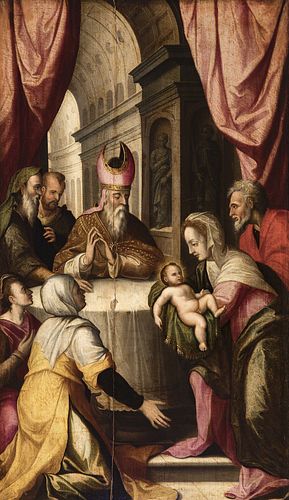Castilian school; XVI century. "The presentation of Jesus in the temple". Oil on panel.
Lot 45
About Seller
Setdart Auction House
Carrer Aragó 346
Barcelona
Spain
Setdart Subastas was born in 2004 and is currently the first online art auction in Spain with solidity, prestige and reliability guaranteed by our more than 60,000 users. Setdart has a young, dynamic and enterprising team ready to successfully manage the purchase and sale of art works through custom...Read more
Estimate:
EUR€4,000 - EUR€5,000
$4,301.08 - $5,376.34
Absentee vs Live bid
Two ways to bid:
- Leave a max absentee bid and the platform will bid on your behalf up to your maximum bid during the live auction.
- Bid live during the auction and your bids will be submitted real-time to the auctioneer.
Bid Increments
| Price | Bid Increment |
|---|---|
| EUR€0 | EUR€10 |
| EUR€200 | EUR€25 |
| EUR€500 | EUR€50 |
| EUR€1,000 | EUR€100 |
| EUR€3,000 | EUR€200 |
| EUR€5,000 | EUR€500 |
| EUR€10,000 | EUR€1,000 |
| EUR€20,000 | EUR€2,000 |
| EUR€50,000 | EUR€5,000 |
About Auction
By Setdart Auction House
Nov 3, 2021
Set Reminder
2021-11-03 08:00:00
2021-11-03 08:00:00
America/New_York
Bidsquare
Bidsquare : OLD MASTERS
https://www.bidsquare.com/auctions/setdart-auction-house/old-masters-7786
Setdart Auction House sofia@setdart.com
Setdart Auction House sofia@setdart.com
- Lot Description
Castilian school; XVI century. "The presentation of Jesus in the temple". Oil on panel. Presents repainting, missing in the frame, restorations and fracture in the board. Measurements: 95 x 55 cm; 113 x 75 cm (frame). In this canvas the author narrates the presentation of Jesus in the Temple of Jerusalem, an iconographic theme very repeated throughout the history of art, within the cycle of the life of Jesus. Luke the Evangelist (Luke 2:22-40) narrates the episode, in which Mary and Joseph brought the Child to the temple and, according to custom, offered two turtledoves as a sacrifice. According to the Jewish law of the time, every first-born child was to be consecrated to the Lord, in remembrance of the slaughter of the innocents. In the temple was Simeon, an old man who was reputed to be a righteous man. When he saw the Child, he was convinced that he was acting under the impulse of the Spirit, and he took him in his arms and blessed him, saying the "Nunc dimitis" or Canticle of Simeon. This wise old man was a devout Jew to whom the Holy Spirit had promised that he would not die until he had seen the Savior. The scene is completed by the prophetess Anna, who lived in the temple. Witnessing this event, she began to speak of the Child to all who awaited the redemption of Jerusalem. The oldest preserved plastic version of this episode is found in the mosaic of the triumphal arch of the church of Santa Maria Maggiore in Rome, from the 5th century, where the four protagonists are already depicted. Usually the scene is represented with Mary offering the Child to Simeon, as we see here. In other versions Simeon holds the Child, while Mary makes the offering of the doves. Almost always appears, to one side or in a corner, the prophetess Anna, and sometimes also St. Joseph. On this occasion the attention falls on the figures located in the center of the composition. Spain is, at the beginning of the 16th century, the European nation best prepared to receive the new humanist concepts of life and art due to its spiritual, political and economic conditions, although from the point of view of the plastic forms, its adaptation of those implanted by Italy was slower due to the need to learn the new techniques and to change the taste of the clientele. The painting reflects this desire to return to the classical Greco-Roman world that exalts the individuality of man in his nudes, creating a new style whose vitality surpasses mere copying. Soon the anatomy, the movement of the figures, the compositions with a sense of perspective and balance, the naturalistic play of the folds, the classical attitudes of the figures began to be valued; but the strong Gothic tradition maintains the expressiveness as a vehicle of the deep spiritualistic sense that informs our best Renaissance sculptures. This strong and healthy tradition favors the continuity of religious painting that accepts the formal beauty offered by Italian Renaissance art with a sense of balance. In the first years of the century, Italian works arrived in our lands and some of our artists went to Italy, where they learned first hand the new norms in the most progressive centers of Italian art, whether in Florence or Rome, and even in Naples.
- Shipping Info
-
In-house shipping available. Please inquire at admin@setdart.com.
-
- Buyer's Premium



 EUR
EUR CAD
CAD AUD
AUD GBP
GBP MXN
MXN HKD
HKD CNY
CNY MYR
MYR SEK
SEK SGD
SGD CHF
CHF THB
THB

















